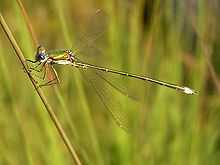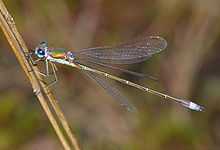Lestes virens
| Lestes virens | |
|---|---|
 | |
| Scientific classification | |
| Kingdom: | Animalia |
| Phylum: | Arthropoda |
| Class: | Insecta |
| Order: | Odonata |
| Family: | Lestidae |
| Genus: | Lestes |
| Species: | L. virens |
| Binomial name | |
| Lestes virens (Charpentier, 1825) | |
The Small Emerald Damselfly or Small Spreadwing, Lestes virens is a damselfly of the family Lestidae. It has the typical appearance of a Lestes damselfly; it has a metallic green body and at rest it holds its wings away from its body.
Distribution and habitat
L. virens is found in most of southern and central Europe and also North Africa. The sub-species L. v. virens is found in the south of the range in Spain, southern France, Sardinia and North Africa. L. v. vestalis is found in the north in northern France, Italy, and across central Europe. It is not found in northern Europe or in the UK. It is a damselfly of still waters and is found in lakes, ponds, ditches and bogs. It is found in well vegetated locations.
 Lestes virens vestalis male |
 Lestes virens female |
Identification
L. virens looks very similar to the other members of the Lestes. It has a metallic green body and at rest holds its wings away from its body. L. virens is smaller than L. sponsa. It has a pale brown pterostigma edged laterally with white and its anal appendages are pale coloured/yellowish. L. sponsa and L. dryas both have black anal appendages.
There are two sub-species L. v. virens and L. v. vestalis. In L. v. virens the yellow line which runs along the humeral suture is unbroken and almost reaches the base of the forwing whereas in L. v. vestalis the yellow line is reduced and broken and does not reach the forewing. L. v. virens is found in the south of its range and L. v. vestalis is found in the north. The separation of L. virens into two subspecies has been called into question by Askew (2004)

Behaviour
Flight period is from June to September but can be from April in the south of its range. L. virens like dense vegetation on the edge of ponds where they feed, mate and lay eggs. L. virens is a univoltine species. After mating the female lays its eggs above water on plant stems, the eggs go through a period of rapid development and then enter diapause. They overwinter as developed eggs and then the larvae hatch out in spring. The larvae develop very quickly.
See also
References
- Askew, R.R. (2004) The Dragonflies of Europe. (revised ed.) Harley Books. pp58–66. ISBN 0-946589-75-5
- d'Aguilar, J., Dommanget, JL., and Prechac, R. (1986) A field guide to the Dragonflies of Britain, Europe and North Africa. Collins. pp168–178. ISBN 0-00-219436-8
- Gibbons, R.B., (1986). Dragonflies and Damselflies of Britain and Northern Europe. Country Life Books. ISBN 0-600-35841-0. pp54–62.
External links
 Media related to Lestes virens at Wikimedia Commons
Media related to Lestes virens at Wikimedia Commons